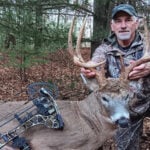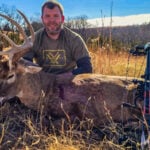Finding DIY fall black bear success just might be easier than you think.
When most bowhunters think of black bear they envision guarding bait, or maybe chasing hounds over rugged terrain. While both of these hunting approaches offer their own excitement and challenges, they make it difficult for the do-it-yourself bowhunter to participate. Even if you live in a state where baiting is legal, it requires a huge outlay of expense and time many just don’t have. In regards to hounds, obviously few of us have access to a pack of well-trained hounds. In bear hunting such ploys remain the territory of guided hunts.
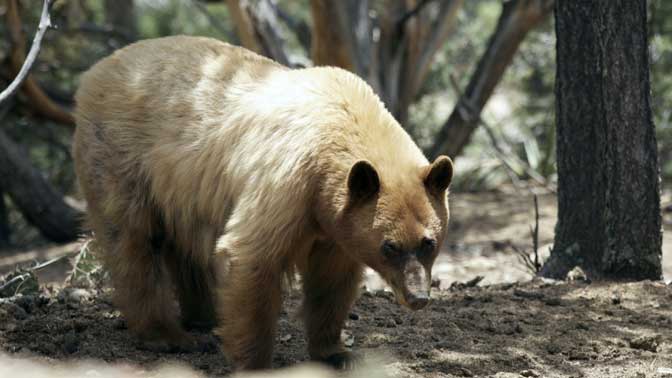
While many hunters are turning their efforts toward deer hunting, opportunities abound for fall black bear hunting across the country.
But the intrepid DIY hunter can find black bear success by employing old-fashioned hunting techniques regularly used for traditional quarry such as deer and elk. This, obviously, involves spot-and-stalk, stand hunting or still-hunting approaches any bowhunter can enjoy on their own terms. It may also come as a surprise to learn such hunts can prove quite successful. In fact, I’ve tagged more bears on my own, from the ground, than I have over bait (I’ve been to Canada on several occasions, even baiting bears legally in Idaho) and chasing hounds (I once owned my own hounds while outfitting). It’s also my contention that hunters willing to invest the same amount of time and effort they would pursuing deer or elk hunt will find regular success on bears.
Black bears are apex animals, so while there might be fewer of them in a given habitat than mule deer or whitetail, bears are also more visible and prone to wandering throughout the day, not just prime early and late hours. A black grub on a distant meadow or clear-cut is much more visible than a brown deer, for instance. And, I’ve encountered just as many black bears in the wild during hot midday as I have during low-light hours favored by deer and elk.
There are also certain factors that tip the scales in your favor, given the right approach and enough concerted effort. Here is how to create a successful fall bear season this year.
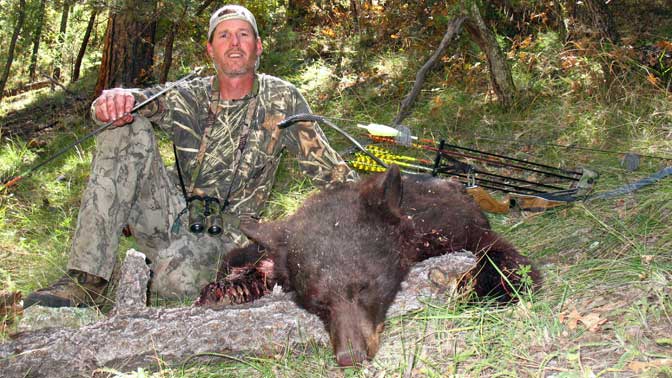
The author stalked this bear to within recurve range while it munched on acorns.
Follow the Food
Bears are always hungry and on the lookout for food. Their survival essentially depends on it. Bears must put on serious fat reserves during the fall to assure they can sleep through the long months of winter hibernation and emerge in good health. This is one reason bears might be found on the prod nearly any hour of the day. Putting on winter fat is a full-time job for fall bears. So where there’s food, you will find bears.
Fall bear hunting becomes most predictable in regions where food is scarcer or at least found in concentrated areas. This makes the West a top destination for fall black-bear success—though food is also the great equalizer in Eastern woods.
In the West, in particular, there is nearly always a concentrated food source much preferred by area bears. While seasonal or cyclic crops might prove extensive, they at least give you a solid starting point. For example, Western pinon nuts are a favorite bear food, not only tasting good, but providing plenty of fat-producing calories. And while pinon pines aren’t exactly scarce in many areas of the West, it does immediately eliminate the need to scout out areas dominated by ponderosa pines or firs. Juniper berries are another popular Western bear food, the slightly sweet fruit often producing when other crops fail during droughts. Of course, the sweet acorns of Gamble’s or blue oaks are always a favorite with Western bears, the later offering the plus of growing at lower elevations where cover is scantier and glassing easier. I have also had great fun bowhunting black bears down in desert foothills gobbling the sweet-red fruit of the prickly-pear cactus.
In the East various acorns, especially those from the sweeter white oak, are a big draw for bears. You know your hunting area better than I, but there are always regional favorites that bring bears out of the woodwork. In the Northwest where I now live, for instance, sweet blackberries and feral apple and pear trees are always a sure bet for discovering bear sign during fall months. In the Southeast, behemoth black bears wander into standing corn fields to feast on corn on the cob. In Saskatchewan and Alberta I’ve witnessed multiple bears grazing in oat and barley fields.
Initially discovering what the preferred fare of the year is requires covering a lot of ground. Once you find an area where bears are feeding it will be wholly obvious, as bears do indeed poop in the woods, and often. Poking at scat quickly reveals the preferred fare of the week. It’s then a matter of staking out concentrations of that foodstuff (setting a stand over apple trees works excellent here) or glassing areas where that food is abundant (I’ve stalked and tagged numerous bears off of oak thickets, pinon and juniper ridges, and successfully still-hunted them in blackberry brambles).
Let available cover and common sense dictate how you approach each situation, whether sitting or glassing, and arrive to put in a full day, as concentrations of food can bring bears around any time of day. One of my most exciting bears, for instance, I shot with recurve bow at 1:30 on a hot September day while he consumed western acorns. When I find concentrations of bear scat and tracks, I’ll happily sit and glass, or guard from a stand, that area from dusk till dawn.
Don’t Discount Water
During warm early seasons always keep water in mind. All-day movement under a hot sun, all that thick fur, and consuming large quantities of mast, serve to make bears thirsty. They will visit water regularly under such conditions, at any hour of the day.
Waterholes and springs being used by bears are easy to recognize, tell-tale tracks in mud at the water’s edge telling the tale. If watering sites prove rocky, such as ground around springs, don’t hesitate to deploy a trail camera. In fact, a number of trail cameras scattered around various ponds, tanks and springs can give you options, one place revealing a bigger bear, or a color-phase that you find especially appealing. You may even discern a pattern, giving you more options, hunting food mornings, for instance, guarding water evenings for a change of pace.
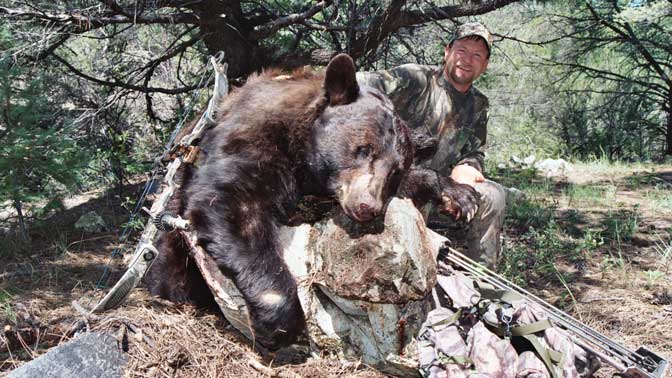
Food and water will be key to success on bears in the fall. Find the water source on a warm fall day and you just might find a bear within bow range.
Bears are plentiful in most North American habitats. There’s no reason a DIY hunt should be viewed as a negative, as plenty of bears are stalked by bowhunters each season. They certainly aren’t as wound-up as deer or elk, and their eyesight and hearing are only average by comparison. Stay on the right side of the wind (bears have better noses than deer!), step softly and move slowly, and black bears are generally quite approachable. And there’s simply nothing more exciting than stalking a black bear on the same ground he occupies, taking him eye to eye!

 By
By 